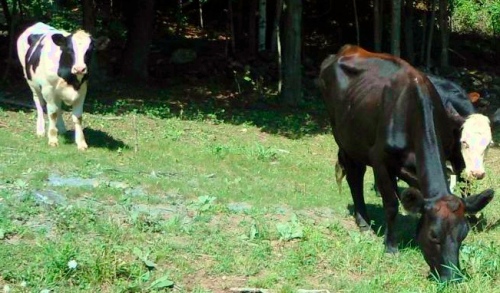When authorities arrived at the small-scale beef farm at which cows were starving to death, Luna was found nursing her calf — and the calf of a mother who had become too depleted to produce milk. Even though Luna’s own malnourished body had begun to digest itself, she generously “adopted” a calf who otherwise would have starved.
Luna now grazes the back pastures at VINE, along with her biological daughter Orchid and her adopted daughter Oryx. She’s not the only exceptional mother among us. Jan (also known as Liberty) had been used to breed calves for the beef industry but was not willing to see another calf go to that fate. Pregnant, she jumped a fence and gave birth in the forest, where she tended her son Justin (also known as Justice) and eventually found her way to sanctuary.
Also among us are the ghosts of the sons and daughters of the former “dairy” cows now living at the sanctuary, each of whom was forced to bear and then grieve multiple calves while being milked for human consumption: Addison, Autumn, Blake, Coco, Gertrude, Princess, Rose, Solstice.
Gertrude and Solstice were lucky in that each was allowed, by chance, to nurture the last of many calves. Gertrude was retired to another sanctuary while pregnant with her son Rupert, who also now lives at VINE. Solstice stepped on one of her teats—the distended and often infected udders of cows exploited for dairy hang down so low that this is not uncommon—and could no longer be mechanically milked. Luckily, this mishap occurred just after she gave birth, so she and her calf Equinox were both allowed to be redeemed by a kindly neighbor, who conveyed them to VINE when she found she could not care for them herself.
All uses of animals in captivity depend upon forced breeding. Farms, pet shops, vivisection labs and zoos all depend upon human-engineered animal reproduction. No animal under the control of these flesh trades may opt out of compulsory heterosexuality. If the people decide they will breed, then breed they will, even if electroejaculation and forced impregnation are required to make it happen. None may choose their own partners. And no mother may say what will happen to her child.
And so, every Mother’s Day, we are so sorrowful, thinking of all the nonhuman mothers who suffer so grievously so that human children can enjoy the fleeting pleasure of ice cream sundaes.
We’ve been saying for some time that we will be launching an explicitly feminist anti-dairy campaign, and we have been hatching plans. One component of the strategy must be to induce human mothers—who tend to make the dietary decisions for their families—to feel empathy for cows. We know that one component of the existing state of affairs is that most people sincerely still do not realize that cows must be impregnated, give birth, and then be dispossessed of their calves so that dairy operators can collect the milk meant for those calves. But we don’t know what else the hold-up might be. We do not yet understand what might be blocking human mothers (who have, perhaps, breast-fed their own children) from experiencing the kind of empathy for cow mothers that would make cow’s milk repugnant to them.
So, here’s our Mother’s Day challenge to you. On Sunday (or soon after), while thoughts of motherhood are in the air, have conversations with any non-vegan mothers you know:
- First, find out what they “know” about dairy
- Next, kindly clarify the facts
- Then, invite them to empathize
- Tell us what happens next
To invite them to empathize, you might say something like, “I wonder what that feels like” or “Can you imagine?” The idea is to prompt them to imagine themselves into the situation and emotions of a cow confined on a dairy farm. You might, as the conversation proceeds, describe behavior like “some mothers bellow for days after their calves are taken away” or “some mothers break down gates, trying to reach their calves” or facts like “their nipples are hooked up to machines twice each day,” but don’t name the associated emotions, since that might short-circuit rather than encourage the act of empathic imagination you want them to undertake.
So, the steps are : question, inform, inspire empathy. Proceed from a position of friendly curiosity. Exercise your own empathic imagination by trying to feel your own way into where your partner in conversation is coming from. What’s holding her back from feeling, and acting on, empathy for other mothers?
Don’t forget to tell us how it goes!






Barbara